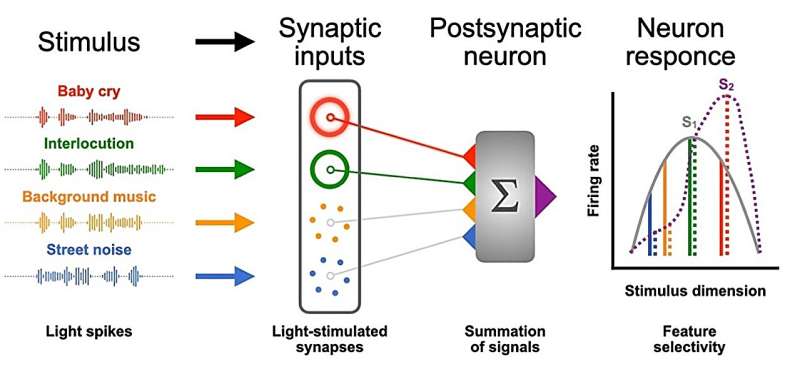The quest for more efficient and versatile computing methods has given rise to innovative solutions, moving beyond traditional digital architectures. The limitations of the von Neumann architecture, which separates memory from processing units, have prompted the exploration of new frontiers in artificial intelligence.
Collaborations between physicists and neuroscientists are at the forefront of these developments, uniting diverse expertise to create novel solutions for neuromorphic computing. A new publication from Opto-Electronic Science discusses light-stimulated adaptive artificial synapse based on nanocrystalline metal-oxide film.
The human brain’s remarkable efficiency is attributed to its spiking mode of information transmission and the seamless integration of information and memory within its neural units. These principles have inspired the development of spiking neural networks (SNNs), offering low-power, high-data-processing solutions for artificial intelligence tasks. Such interdisciplinary collaborations have enabled the infusion of neuroscience principles into the design of neuromorphic systems, making them more biologically plausible.
Neuroscientists bring their profound understanding of the brain’s operation to the table, guiding physicists in the development of materials and devices that mimic the behavior of biological synapses. Their insights into synaptic plasticity, learning, and memory play a pivotal role in shaping the direction of this research. This cross-disciplinary synergy opens the possibility of using neuromorphic approaches to simulate and test a number of neurobiological hypotheses using artificial synapses.
The usage of optical signals for transmission of synaptic spikes between neurons is a significant innovation, one that has been made possible through the collaborative work of physicists and neuroscientists. Optoelectronic approaches, guided by the knowledge of neural signal transmission, could reduce heat losses and enable a multitude of network connections and high-rate spike transmission. These advances, driven by the combined expertise of physicists and neuroscientists, offer a promising avenue for future developments in neuromorphic computing.
In this context, this paper introduces a groundbreaking light-stimulated adaptive artificial synapse based on a nanocrystalline zinc oxide film. This collaborative effort showcases the fusion of physics and neuroscience, as the material properties are fine-tuned to replicate neural behavior. The result is an artificial synapse that efficiently transmits and processes information, drawing from the knowledge of both physicists and neuroscientists. This interdisciplinary approach not only propels neuromorphic computing forward but also deepens our understanding of the brain’s remarkable capabilities.
In this study, a group of scientists led by Professor Andrey Fedyanin of the Faculty of Physics of Moscow State University, using the materials science expertise of colleagues from the Faculty of Chemistry, was able to demonstrate biosimilar properties for optoelectric structures based on zinc oxide.
As a result of a thoughtful discussion of the possibilities of optoelectric structures with Konstantin Anokhin, a neuroscientist, Academician of the Russian Academy of Science and Director of the Institute for Advanced Brain Studies, Lomonosov Moscow State University it was possible to frame a set of experiments that exposed the spike properties of artificial synapses and demonstrated the effects of adaptation. This research was achievable only due to established interdepartmental relationships at Lomonosov Moscow State University.
The development of an adaptive artificial synapse based on a nanocrystalline zinc oxide film represents a significant leap in the field of neuromorphic computing. This artificial synapse not only replicates essential properties of biological synapses but also offers unique advantages in terms of energy efficiency and versatility.

The photoconductivity of this zinc oxide-based artificial synapse exhibits spike-type signal responses, closely resembling the behavior of biological synapses. This means it can efficiently transmit and process information in a manner akin to how neurons communicate with one another.
One of the most intriguing aspects of this artificial synapse is its memory capabilities. It possesses both short-term memory (STM) and long-term memory (LTM), a crucial feature for many cognitive tasks. This LTM is maintained for an extended duration, making it a valuable resource for information storage and retrieval in neuromorphic systems.
The transition from STM to LTM is a pivotal milestone in the development of artificial synapses, and this nanocrystalline zinc oxide film-based synapse successfully achieves it. This transition is a key feature in biological synapses and has now been replicated in an artificial system, bringing us closer to emulating the cognitive processes of the human brain.
Another remarkable property of this artificial synapse is its paired-pulse facilitation (PPF). This phenomenon, where the second pulse elicits a stronger response than the first, is a critical feature in neural systems and has significant implications for information processing and learning.
Furthermore, this artificial synapse retains memory from previous exposures, a feature essential for continuous learning and adaptation. This ability to store and retrieve past information allows it to adapt to changing conditions and enhance its performance over time.
Perhaps the most exciting aspect of this paper is the development of spike-frequency adaptation. This property, common in biological neurons, allows the artificial synapse to adjust its response based on the frequency of incoming signals. This adaptation provides a level of complexity and versatility that is essential for emulating the intricate functioning of the human brain.
In summary, the nanocrystalline zinc oxide film-based adaptive artificial synapse marks a significant step toward creating neuromorphic computing systems that replicate the efficiency and adaptability of the human brain. Its ability to reproduce fundamental synaptic behaviors, including STM, LTM, PPF, and spike-frequency adaptation, makes it a promising candidate for future neuromorphic chips and sensorics systems. This development not only showcases the potential for light-stimulated synaptic devices but also opens the door to more advanced and biologically inspired computational technologies.
More information:
Igor S. Balashov et al, Light-stimulated adaptive artificial synapse based on nanocrystalline metal-oxide film, Opto-Electronic Science (2023). DOI: 10.29026/oes.2023.230016
Provided by
Compuscript Ltd
Citation:
Light-stimulated adaptive artificial synapse based on nanocrystalline metal-oxide film (2023, December 13)
retrieved 13 December 2023
from https://techxplore.com/news/2023-12-light-stimulated-artificial-synapse-based-nanocrystalline.html
This document is subject to copyright. Apart from any fair dealing for the purpose of private study or research, no
part may be reproduced without the written permission. The content is provided for information purposes only.

